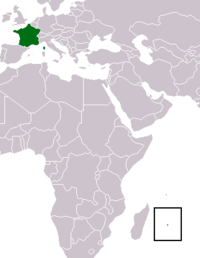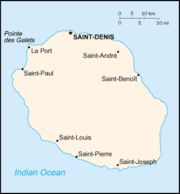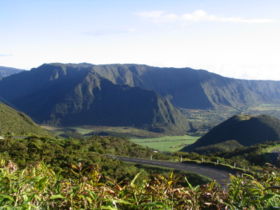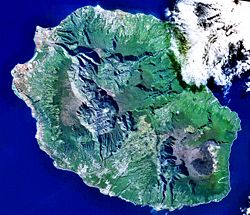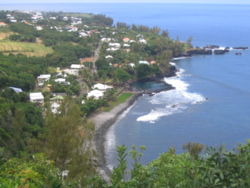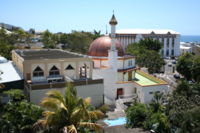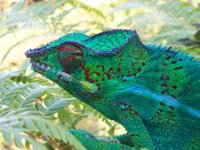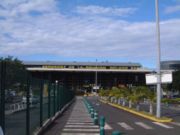Réunion
2008/9 Schools Wikipedia Selection. Related subjects: Africa; African Countries
| Région Réunion | ||
|---|---|---|
|
 |
|
| Region flag | Region logo | |
| Location | ||
|
||
| Administration | ||
| Capital | Saint-Denis | |
| Regional President | Paul Vergès ( PCR) (since 1998) |
|
| Departments | Réunion | |
| Arrondissements | 4 | |
| Cantons | 49 | |
| Communes | 24 | |
| Statistics | ||
| Land area1 | 2,512 km² | |
| Population | (Ranked 21st) | |
| - January 1, 2007 est. | 793,000 | |
| - March 8, 1999 census | 706,300 | |
| - Density (2007) | 316/km² | |
| 1 French Land Register data, which exclude lakes, ponds, and glaciers larger than 1 km² (0.386 sq. mi. or 247 acres) as well as the estuaries of rivers |
||
Réunion (French: Réunion or formally La Réunion; previously Île Bourbon) is an island located in the Indian Ocean, east of Madagascar, about 200 km (130 miles) south west of Mauritius, the nearest island.
Administratively, Réunion is one of the overseas départements of France. Like the other overseas departments, Réunion is also one of the twenty-six regions of France (being an overseas region) and an integral part of the Republic with the same status as those situated on the European mainland.
Réunion is an outermost region of the European Union, and thus the currency used is the euro. In fact, due to its location in a time zone to the east of Europe, Réunion was the first region in the world to use the euro, and the first ever purchase using the euro occurred at 12.01 a.m., when the former mayor of Saint-Denis René-Paul Victoria bought a bag of lychees at a market.
History
Arab sailors formerly called the island Adna Al Maghribain (“Western Island”). The Portuguese were the first Europeans to visit, finding it uninhabited in 1513, and naming it Santa Apollonia, after Saint Apollonia.
The island was then occupied by France and administered from Port Louis, Mauritius. Although the French flag was hoisted by François Cauche in 1638, Santa Apollonia was officially claimed by Jacques Pronis of France in 1642, when he deported a dozen French mutineers to the island from Madagascar. The convicts were returned to France several years later, and in 1649, the island was named Île Bourbon after the royal house.
“Réunion” was the name given to the island in 1793 by a decree of the Convention with the fall of the House of Bourbon in France, and the name commemorates the union of revolutionaries from Marseille with the National Guard in Paris, which took place on August 10, 1792. In 1801, the island was renamed "Île Bonaparte," after Napoleon Bonaparte. The island was taken by the British navy led by Commodore Josias Rowley in 1810, who used the old name of “Bourbon”. When it was restored to France by the Congress of Vienna in 1815, the island retained the name of "Bourbon" until 1848, when the fall of the restored Bourbons during the revolutions during that year meant that the island became “Réunion” once again.
From the 17th to the 19th centuries, French immigration supplemented by influxes of Africans, Chinese, Malays, and Indians gave the island its ethnic mix. The opening of the Suez Canal in 1869 cost the island its importance as a stopover on the East Indies trade route.
Réunion became a département d'outre-mer (overseas department) of France on March 19, 1946. Its département code is 974.
Between 15 and 16 March 1952, Cilaos at the centre of Réunion received 1,869.9 mm (73.6 in) of rainfall. This is the greatest 24-hour precipitation total ever recorded on earth. The island also holds the record for most rainfall in 72 hours, 3,929 mm (154.7 in) at Commerson's Crater in March, 2007.
In 2005 and 2006 Réunion was hit by a crippling epidemic of chikungunya, a disease spread by mosquitoes. According to the BBC News, 255,000 people on Réunion had contracted the disease as of 26 April 2006. The disease also spread to Madagascar and to mainland France through airline travel. The disease led to more than 200 deaths on Réunion. The French government under Prime Minister Dominique de Villepin sent an emergency aid package worth 36 million euros ($42.8M U.S. dollars) and deployed approximately five hundred French troops in an effort to eradicate mosquitoes. Chikungunya means "that which bends" in the Makonde language of the Tanzania/Mozambique border region where it was first identified. It can cause dehydration, extreme pain and high fevers and in some rare cases can be fatal. There is no known cure.
Politics
Réunion sends five deputies to the French National Assembly and three senators to the French Senate.
Arrondissements, cantons, and communes
Administratively, Réunion is divided into 4 arrondissements, 24 cantons, and 24 communes. It is a French overseas département as well as a French region. The low number of communes, compared to French metropolitan departments of similar size and population, is unique; most Réunionnaises communes encompass several localities, sometimes separated by significant distances. Réunion is part of the Indian Ocean Commission.
Major communities
- Saint-Benoît
- Le Port
- Le Tampon
- Saint-André
- Saint-Denis
- Saint-Louis
- Saint-Paul
- Saint-Pierre
Geography
The island is 63 kilometres (39 miles) long; 45 kilometres (28 miles) wide; and covers 2512 square kilometres (970 square miles). It is similar to the island Hawaii insofar as both are located above hotspots in the Earth's crust.
The Piton de la Fournaise, a shield volcano on the eastern end of Réunion Island, rises more than 2631 metres (8632 ft) above sea level and is sometimes called a sister to Hawaiian volcanoes because of the similarity of climate and volcanic nature. It has erupted more than 100 times since 1640 and is under constant monitoring. It most recently erupted on 4 April 2007. The lava flow from this eruption has been estimated at 3 million m3 (about 4 million cubic yards) per day. The Piton de la Fournaise is created by a hotspot volcano, which also created the Piton des Neiges and the islands of Mauritius and Rodrigues.
The Piton des Neiges volcano, the highest point on the island at 3070 metres (10,069 ft) above sea level, is north west of the Piton de la Fournaise. Collapsed calderas and canyons are south west of the mountain. Like Kohala on the Big Island of Hawaii, the Piton des Neiges is extinct. Despite its name, snow (French: neige) practically never falls on the summit.
The slopes of both volcanoes are heavily forested. Cultivated land and cities like the capital city of Saint-Denis are concentrated on the surrounding coastal lowlands.
Réunion also has three calderas: the Cirque de Salazie, the Cirque de Cilaos and the Cirque de Mafate. The last is accessible only by foot or helicopter.
Economy
Sugar was traditionally the chief agricultural product and export. Tourism is now an important source of income. In 2006 the GDP per capita of Réunion at market exchange rates, not at PPP, was 16,244 euros (US$20,406).
Demographics
Réunion contains most of the same ethnic populations as Mauritius: Indian, African, Malagasy, Chinese and ethnic French - but in different proportions. Creoles (a name given to those born on the island, of various ethnic origins), make up the vast majority of the population. Whites make up approximately one-quarter of the population, Indians make up 21%, and people of Chinese ancestry form most of the remainder. There are also some people of Vietnamese ancestry on the island, though they are very few in number.
While Gujarati, followed closely by Tamil people make up the majority of the Indo-Réunionnaise people, people of Hindi, Urdu and other origins form the remainder of the population.
Réunion is very similar in culture, ethnic makeup, language and traditions to Mauritius and Seychelles.
Historical population
| 1671 estimate |
1696 estimate |
1704 estimate |
1713 estimate |
1717 estimate |
1724 estimate |
1764 estimate |
1777 estimate |
1789 estimate |
|---|---|---|---|---|---|---|---|---|
| 90 | 269 | 734 | 1,171 | 2,000 | 12,550 | 25,000 | 35,100 | 61,300 |
| 1826 estimate |
1830 estimate |
1848 estimate |
1849 estimate |
1860 estimate |
1870 estimate |
1887 census |
1897 census |
1926 census |
| 87,100 | 101,300 | 110,300 | 120,900 | 200,000 | 212,000 | 163,881 | 173,192 | 182,637 |
| 1946 census |
1954 census |
1961 census |
1967 census |
1974 census |
1982 census |
1990 census |
1999 census |
2007 estimate |
| 241,708 | 274,370 | 349,282 | 416,525 | 476,675 | 515,814 | 597,823 | 706,300 | 793,000 |
| Official figures from past censuses and INSEE estimates. | ||||||||
Religion
The predominant religion is Roman Catholicism (86% of the population in 1995), with Hinduism, Islam and Buddhism also represented amongst others. Rastafarism is very present, too, but is not officially recognized.
Language
Réunionnaise Creole is the main language of the country, though French is more commonly spoken. Mandarin, Hakka and Cantonese are spoken by the Chinese community, but their numbers are dropping as younger generations start to converse in French. The number of speakers of Indian languages is also dropping sharply. Arabic is taught in mosques and spoken by a small community of Arabs. The island's community of Muslims from North Western India and elsewhere are also commonly referred to as Arabs.
Public health
Réunion experienced in 2005/2006 an epidemic of Chikungunya, a viral disease that infected almost a third of the population. See the History section for more details.
Culture
Réunionese culture is a blend (métissage) of European, African, Indian, Chinese and insular traditions.
The most widely spoken language, Réunion Creole, derives from French, with many idiosyncrasies. Réunion Creole is now taught in some schools. However, an official orthography has yet to be agreed upon.
Local food and music blend influences from Africa, India, China and Europe.
Wildlife
Réunion is home to a variety of birds such as the paille en queue. Its largest native land animal is the tenrec. Much of the West coast is ringed by coral reef which harbours, amongst others, sea urchins, conga eels and parrot fish. Sea turtles also visit the coastal waters.
Transport
Roland Garros Airport, handling flights to Africa and Europe serves the island. Pierrefonds Airport, a smaller airport, has some flights to Africa and Madagascar.

